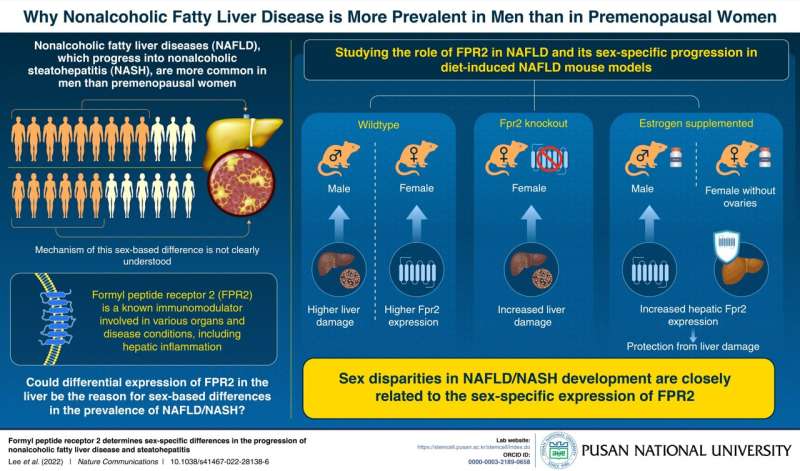Scientists discover why women are more resistant to nonalcoholic fatty liver disease than men

One of the most common disorders globally, nonalcoholic fatty liver disease (NAFLD) is a leading cause of death worldwide. Its progressive form, called "nonalcoholic steatohepatitis" (NASH), affects about 30% of all NAFLD patients, and can lead to cirrhosis and liver cancer. Despite many research efforts, we still do not understand the underlying mechanisms of NAFLD/NASH and, consequently, lack an effective treatment.
One thing we do know, however, is that it seems to be more frequent among men than women, especially premenopausal women. Why this is so is not entirely clear, but current evidence suggests that the sex hormone estrogen plays a protective role. On the other hand, the protein formyl peptide receptor 2 (FPR2) is known to play an important role in mediating inflammatory responses in multiple organs. However, no study so far has determined its role in the liver. Could FPR2 be involved in the sex-related differences regarding NAFLD prevalence and severity?
Addressing this question, a research team led by Professor Youngmi Jung of Pusan National University, Korea, recently conducted a study using mice model, shedding light on the role of FPR2 in NAFLD/NASH and its relationship to the observed sex-based differences. This work is among the very few studies on NAFLD that relies on sex-balanced animal experiments rather than the more common male-only designs. This paper was made available online on 31 January 2022 and was published in Nature Communications.
The researchers first found that Fpr2 was highly expressed in healthy livers of female mice. Furthermore, it was expressed differently in the livers of male and female mice that were fed a special NAFLD-inducing diet. Silencing the Fpr2 gene made the male and female mice equally vulnerable to NAFLD, suggesting that FPR2 has a protective effect on the liver.
Interestingly, the researchers also found that FPR2 production in the liver is mediated by estrogen. Males supplemented with external estrogen produced more Fpr2 and were more resistant to NAFLD, whereas females that had their ovaries removed exhibited reduced liver Fpr2 levels. "Taken together, our findings suggest that FPR2 is a potential therapeutic target for developing pharmacological agents to treat NAFLD/NASH," says Prof. Jung. "In addition, our results could help in the development of gender-based therapies for NASH."
This unprecedented discovery of the female-specific production of FPR2 in the liver and its role in providing resistance against NAFLD/NASH will hopefully pave the way not only for novel treatments but also a more comprehensive and sex-aware approach when doing science. In this regard, Prof. Jung remarks, "Our research highlights the pressing need for designing and developing better sex-balanced animal experiments, considering that the sex-specific expression of FPR2 in the liver had been completely overlooked in previous studies."
More information: Chanbin Lee et al, Formyl peptide receptor 2 determines sex-specific differences in the progression of nonalcoholic fatty liver disease and steatohepatitis, Nature Communications (2022). DOI: 10.1038/s41467-022-28138-6


















